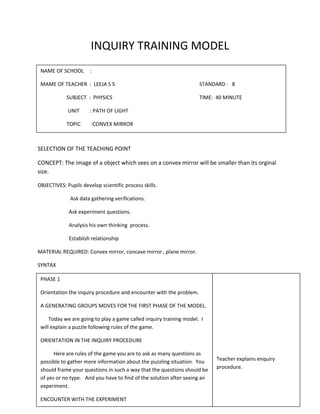
Inquiry training model
- 1. INQUIRY TRAINING MODEL SELECTION OF THE TEACHING POINT CONCEPT: The image of a object which sees on a convex mirror will be smaller than its orginal size. OBJECTIVES: Pupils develop scientific process skills. Ask data gathering verifications. Ask experiment questions. Analysis his own thinking process. Establish relationship MATERIAL REQUIRED: Convex mirror, concave mirror , plane mirror. SYNTAX NAME OF SCHOOL : MAME OF TEACHER : LEEJA S S STANDARD : 8 SUBJECT : PHYSICS TIME: 40 MINUTE UNIT : PATH OF LIGHT TOPIC :CONVEX MIRROR PHASE 1 Orientation the inquiry procedure and encounter with the problem. A GENERATING GROUPS MOVES FOR THE FIRST PHASE OF THE MODEL. Today we are going to play a game called inquiry training model. I will explain a puzzle following rules of the game. ORIENTATION IN THE INQUIRY PROCEDURE Here are rules of the game you are to ask as many questions as possible to gather more information about the puzzling situation. You should frame your questions in such a way that the questions should be of yes or no type. And you have to find of the solution after seeing an experiment. ENCOUNTER WITH THE EXPERIMENT Teacher explains enquiry procedure.
- 2. Once upon a time there lived a very beautiful princes in Chin, named Ya sin Shu. She was very conscious for her beauty and her body structure. She was ready to use any type of material to increase her beauty. On her birthday, everybody gave her different types of face creams, tonic for increasing her glow of face, mirror for looking herself, make up set for increasing her beauty, and fruits for good health. On applying creams, having tonic & fruits, using make up set, she looked at the mirror. “Oh! No!!” she screamed. Her face was smaller than the original one. Now you have to find out the reason by asking questions PHASE 2 DATA GATHERING VERIFICATIONS To find out details you may now begin to ask questions. S: Was it a dream of princess? T: No S: Did it happen due to gifts? T: Yes S: Was that Fruits are magical one? T: No S: Did it happen due to creams? T: No S: Did the tonic is for reducing size? T: No S: Was that make up set was given by enemy? T : No S: Was that a magical mirror? T: No S: It is not a plane mirror. Right? T: Yes you are right. Now I will show some materials which will help you to find the solution. PHASE 3 DATA GATHERING EXPERIMENTATION Teacher present the event. Students ask questions
- 3. T: I have different types of mirrors in my hand and by observing the mirrors you have to find the solution. And you may ask questions. S: Can you allow doing our self? T: Yes. S: The image of the objects is different in size. Is it? T: Yes. S: The mirror which has budged surface will give the image of smaller size. Is it? T: very correct. PHASE 4 FORMULATION OFEXPLANATION T: Now can you say the reason for the first story? S: The mirror has a budged surface. T: Yes. S: The image formed is smaller that original size. T: yes. You are correct. Now can you say the name of the mirror? S: No T: It is known as convex mirror. Can you suggest some incidents where convex mirror is used? S: In vehicle’s rearview mirror. T: very good. PHASE 5 ANALYSIS OF INQUIRY PROCESS T: Now you analyze the inquiry procedure. What kind of questionbs did you ask? S: Questions related to mirrors. And by seeing the different type of mirrors and its image we found out that the mirror used was a convex mirror. T: Very good. Thus you formed solutions of the problem by asking questions. Students do experiments. Students develop hypothesis. Students apply information Students analyses ITM Teacher summarizes